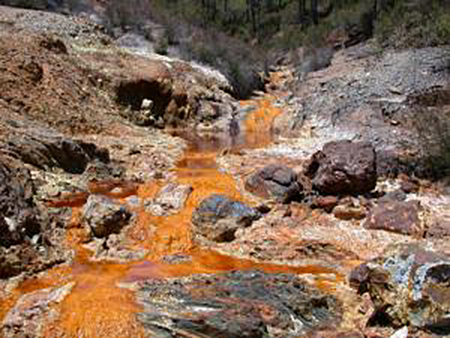Can Mine Drainage be Used to Treat Fracking Waste Water?
Monday, January 13, 2014

DURHAM, NC – Much of the naturally occurring radioactivity in fracking wastewater might be removed by blending it with another wastewater from acid mine drainage, according to a Duke University-led study.
Can two wrongs make a right?
“Fracking wastewater and acid mine drainage each pose well-documented environmental and public health risks. But in laboratory tests, we found that by blending them in the right proportions we can bind some of the fracking contaminants into solids that can be removed before the water is discharged back into streams and rivers,” said Avner Vengosh, professor of geochemistry and water quality at Duke’s Nicholas School of the Environment.
Protecting fresh water
Blending fracking wastewater with acid mine drainage also could help reduce the depletion of local freshwater resources by giving drillers a source of usable recycled water for the hydraulic fracturing process, he added.
“Scarcity of fresh water in dry regions or during periods of drought can severely limit shale gas development in many areas of the United States and in other regions of the world where fracking is about to begin,” Vengosh said. “Using acid mine drainage or other sources of recycled or marginal water may help solve this problem and prevent freshwater depletion.”
The peer-reviewed study was published in late December 2013 in the journal Environmental Science & Technology.
Fracturing
In hydraulic fracturing – or fracking, as it is sometimes called – millions of tons of water are injected at high pressure down wells to crack open shale deposits buried deep underground and extract natural gas trapped within the rock. Some of the water flows back up through the well, along with natural brines and the natural gas. This “flowback fluid” typically contains high levels of salts, naturally occurring radioactive materials such as radium, and metals such as barium and strontium.
A study last year by the Duke team showed that standard treatment processes only partially remove these potentially harmful contaminants from Marcellus Shale wastewater before it is discharged back into streams and waterways, causing radioactivity to accumulate in stream sediments near the disposal site.
Mine drainage
Acid mine drainage flows out of abandoned coal mines into many streams in the Appalachian Basin. It can be highly toxic to animals, plants and humans, and affects the quality of hundreds of waterways in Pennsylvania and West Virginia.
Because much of the current Marcellus shale gas development is taking place in regions where large amounts of historic coal mining occurred, some experts have suggested that acid mine drainage could be used to frack shale gas wells in place of fresh water.
Can mixing mine drainage and waste water yield results?
“Our analysis suggested that several ions, including sulfate, iron, barium and strontium, as well as between 60 and 100 percent of the radium, had precipitated within the first 10 hours into newly formed solids composed mainly of strontium barite,” Vengosh said.
These radioactive solids could be removed from the mixtures and safely disposed of at licensed hazardous-waste facilities, he said. The overall salinity of the blended fluids was also reduced, making the treated water suitable for re-use at fracking sites.
Andrew J. Kondash, a master’s student in Vengosh’s lab at Duke, was the lead author of the new study. Nathaniel R. Warner, a 2013 PhD graduate of Duke now at Dartmouth University, and Ori Lahav of Technion, in Haifa, Israel, who spent his sabbatical leave at Duke last year, were co-authors.
Funding for the study was provided by Duke’s Nicholas School, and partly by a National Science Foundation Partnerships for International Research and Education grant (NSF-OISE-12-43433).




